-

新人教版高中英语选修2Unit 3 Reading for writing教学设计
The theme of this part is to write an article about healthy diet. Through reading and writing activities, students can accumulate knowledge about healthy diet, deepen their understanding of the theme of healthy diet, and reflect on their own eating habits. This text describes the basic principles of healthy diet. The author uses data analysis, definition, comparison, examples and other methods. It also provides a demonstration of the use of conjunctions, which provides important information reference for students to complete the next collaborative task, writing skills, vivid language materials and expressions.1. Teach Ss to learn and skillfully use the new words learned from the text.2. Develop students’ ability to understand, extract and summarize information.3. Guide students to understand the theme of healthy diet and reflect on their own eating habits.4. To guide students to analyze and understand the reading discourse from the aspects of theme content, writing structure, language expression, etc., 5. Enable Ss to write in combination with relevant topics and opinions, and to talk about their eating habits.1. Guide students to analyze and understand the reading discourse from the aspects of theme content, writing structure, language expression, etc.2. Enable them to write in combination with relevant topics and opinions, and to talk about their eating habits.3. Guide the students to use the cohesive words correctly, strengthen the textual cohesion, and make the expression fluent and the thinking clear.Step1: Warming upbrainstorm some healthy eating habits.1.Eat slowly.2.Don’t eat too much fat or sugar.3.Eat healthy food.4.Have a balanced diet.Step2: Read the passage and then sum up the main idea of each paragraph.

新人教版高中英语选修2Unit 2 Reading for writing教学设计
The theme of this section is to express people's views on studying abroad. With the continuous development of Chinese economic construction, especially the general improvement of people's living standards, the number of Chinese students studying abroad at their own expense is on the rise. Many students and parents turn their attention to the world and regard studying abroad as an effective way to improve their quality, broaden their horizons and master the world's advanced scientific knowledge, which is very important for the fever of going abroad. Studying abroad is also an important decision made by a family for their children. Therefore, it is of great social significance to discuss this issue. The theme of this section is the column discussion in the newspaper: the advantages and disadvantages of studying abroad. The discourse is about two parents' contribution letters on this issue. They respectively express their own positions. One thinks that the disadvantages outweigh the advantages, and the other thinks that the advantages outweigh the disadvantages. The two parents' arguments are well founded and logical. It is worth noting that the two authors do not express their views on studying abroad from an individual point of view, but from a national or even global point of view. These two articles have the characteristics of both letters and argumentative essays1.Guide the students to read these two articles, and understand the author's point of view and argument ideas2.Help the students to summarize the structure and writing methods of argumentative writing, and guides students to correctly understand the advantages and disadvantages of studying abroad3.Cultivate students' ability to analyze problems objectively, comprehensively and deeply

新人教版高中英语选修2Unit 2 Using langauge-Listening教学设计
? B: Absolutely! Getting involved with Chinese cultural activities there definitely helped a lot. I got to practice my Chinese on a daily basis, and I could learn how native Chinese speakers spoke.? A: What do you feel is your biggest achievement?? B: Learning Chinese characters! I have learnt about 1,500 so far. When I first started, I didn't think it was even going to be possible to learn so many, but now I find that I can read signs, menus, and even some easy newspaper articles.? A: What are you most keen on?? B: I've really become keen on learning more about the Chinese culture, in particular Chinese calligraphy. As I have learnt Chinese characters, I have developed a great appreciation for their meaning. I want to explore Chinese characters by learning how to write them in a more beautiful way. ? A: Finally, what do you want to say to anyone interested in learning Chinese?? I have really become keen on learning more about the Chinese culture, in particular Chinese Calligraphy. As I have learnt Chinese character, I have developed a great appreciation for their meaning. I want to explore Chinese characters by learning how to write them in a more beautiful way.? A: Finally, what do you want to say to anyone interested in learning Chinese?? B: I'd say, give it a shot! While some aspects may be difficult, it is quite rewarding and you will be happy that you tried.? A: Thanks for your time. ? B:You're welcome.

新人教版高中英语选修2Unit 3 Using langauge-Listening教学设计
1. How is Hunan cuisine somewhat different from Sichuan cuisine?The heat in Sichuan cuisine comes from chilies and Sichuan peppercorns. Human cuisine is often hotter and the heat comes from just chilies.2.What are the reasons why Hunan people like spicy food?Because they are a bold people. But many Chinese people think that hot food helps them overcome the effects of rainy or wet weather.3.Why do so many people love steamed fish head covered with chilies?People love it because the meat is quite tender and there are very few small bones.4.Why does Tingting recommend bridge tofu instead of dry pot duck with golden buns?Because bridge tofu has a lighter taste.5 .Why is red braised pork the most famous dish?Because Chairman Mao was from Hunan, and this was his favorite food.Step 5: Instruct students to make a short presentation to the class about your choice. Use the example and useful phrases below to help them.? In groups of three, discuss what types of restaurant you would like to take a foreign visitor to, and why. Then take turns role-playing taking your foreign guest to the restaurant you have chosen. One of you should act as the foreign guest, one as the Chinese host, and one as the waiter or waitress. You may start like this:? EXAMPLE? A: I really love spicy food, so what dish would you recommend?? B: I suggest Mapo tofu.? A: Really ? what's that?

新人教版高中英语选修2Unit 4 Learning about Language教学设计
This section guides students to pay attention to the typical context of vocabulary use, helps students accumulate vocabulary around the key vocabulary of this unit, and uses the learned words and word chunks in different contexts to deeply understand their meaning and usage, so as to achieve the purpose of review and consolidation.The teaching design activities aim to guide students to pay attention to the typical context in which the target vocabulary is used, as well as the common vocabulary used in collocation, so that students can complete the sentence with correct words. In terms of vocabulary learning strategies, this unit focuses on cultivating students' ability to pay attention to collocation of words and to use word blocks to express meaning.For vocabulary learning, it is not enough just to know the meaning of a single word, but the most important thing is to master the common collocations of words, namely word blocks.Teachers should timely guide students to summarize common vocabulary collocation, such as verb and noun collocation, verb and preposition collocation, preposition and noun collocation, and so on.1. Guide students to understand and consolidate the meaning and usage of the vocabulary in the context, 2. Guide the students to use the unit topic vocabulary in a richer context3. Let the students sort out and accumulate the accumulated vocabulary, establishes the semantic connection between the vocabulary,4. Enable students to understand and master the vocabulary more effectivelyGuiding the Ss to use unit topic words and the sentence patterns in a richer context.

新人教版高中英语选修2Unit 4 Reading for writing教学设计
假定你是英国的Jack,打算来中国旅行,请你给你的中国笔友李华写一封信,要点如下:1.你的旅行计划:北京→泰山→杭州;2.征求建议并询问他是否愿意充当你的导游。注意:1.词数80左右(开头和结尾已给出,不计入总词数);2.可以适当增加细节,以使行文连贯。参考词汇:故宫 the Forbidden City;泰山 Mount TaiDear Li Hua,I'm glad to tell you that 'm going to visit China.First,I am planning to visit Beijing,the capitalof China,where I am looking forward to enjoying the Great Wall,the Forbidden City and somebeautiful parks.Then I intend to go to visit Mount Tai in Shandong Province.I've heard that it is one ofthe most famous mountains in China and I can't wait to enjoy the amazing sunrise there.After that,I amalso going to Hangzhou.It is said that it is a beautiful modern city with breathtaking natural sights,among which the West Lake is a well- known tourist attraction.What do you think of my travel plan? Will you act as my guide? Hope to hear from you soon.

新人教版高中英语选修2Unit 4 Using langauge-Listening教学设计
The theme of the listening section is " talking about scenery and culture along a journey."The part is designed to further lead the students to understand Canadian natural geography and social environment, and integrated into the cultural contrast by mentioning the long train journey from Beijing to Moscow routes. On this basis, the part activates students related travel experience, lets the student serial dialogue, guides the student to explore further the pleasure and meaning of the long journey, and Chinese and foreign cultural comparison.The part also provides a framework for the continuation of the dialogue, which is designed to provide a framework for students to successfully complete their oral expressions, and to incorporate an important trading strategy to end the dialogue naturally.1. Help students to understand and master some common English idioms in the context, and experience the expression effect of English idioms.2. Guide the students to understand the identity of different people in the listening context, and finish the dialogue according to their own experience.3. Instruct the students to use appropriate language to express surprise and curiosity about space and place in the dialogue, and master the oral strategy of ending the dialogue naturally.1. Instruct students to grasp the key information and important details of the dialogue.2. Instruct students to conduct a similar talk on the relevant topic.

新人教版高中英语选修2Unit 5 Learning about Language教学设计
The purpose of this section of vocabulary exercises is to consolidate the key words in the first part of the reading text, let the students write the words according to the English definition, and focus on the detection of the meaning and spelling of the new words. The teaching design includes use English definition to explain words, which is conducive to improving students' interest in vocabulary learning, cultivating their sense of English language and thinking in English, and making students willing to use this method to better grasp the meaning of words, expand their vocabulary, and improve their ability of vocabulary application. Besides, the design offers more context including sentences and short passage for students to practice words flexibly.1. Guide students to understand and consolidate the meaning and usage of the vocabulary in the context, 2. Guide the students to use the unit topic vocabulary in a richer context3. Let the students sort out and accumulate the accumulated vocabulary, establishes the semantic connection between the vocabulary,4. Enable students to understand and master the vocabulary more effectivelyGuiding the Ss to use unit topic words and the sentence patterns in a richer context.Step1: Read the passage about chemical burns and fill in the blanks with the correct forms of the words in the box.

新人教版高中英语选修2Unit 5 Reading and thinking教学设计
The theme of this activity is to learn the first aid knowledge of burns. Burns is common in life, but there are some misunderstandings in manual treatment. This activity provides students with correct first aid methods, so as not to take them for granted in an emergency. This section guides students to analyze the causes of scald and help students avoid such things. From the perspective of text structure and collaborative features, the text is expository. Expository, with explanation as the main way of expression, transmits knowledge and information to readers by analyzing concepts and elaborating examples. This text arranges the information in logical order, clearly presents three parts of the content through the subtitle, accurately describes the causes, types, characteristics and first aid measures of burns, and some paragraphs use topic sentences to summarize the main idea, and the level is very clear.1. Guide students to understand the causes, types, characteristics and first aid methods of burns, through reading2. Enhance students’ ability to deal withburnss and their awareness of burns prevention3. Enable students to improve the ability to judge the types of texts accurately and to master the characteristics and writing techniques of expository texts.Guide students to understand the causes, types, characteristics and first aid methods of burns, through readingStep1: Lead in by discussing the related topic:1. What first-aid techniques do you know of ?CPR; mouth to mouth artificial respiration; the Heimlich Manoeuvre

新人教版高中英语选修2Unit 5 Using langauge-Listening教学设计
The theme of this section is to learn how to make emergency calls. Students should learn how to make emergency calls not only in China, but also in foreign countries in English, so that they can be prepared for future situations outside the home.The emergency telephone number is a vital hotline, which should be the most clear, rapid and effective communication with the acute operator.This section helps students to understand the emergency calls in some countries and the precautions for making emergency calls. Through the study of this section, students can accumulate common expressions and sentence patterns in this context. 1.Help students accumulate emergency telephone numbers in different countries and learn more about first aid2.Guide the students to understand the contents and instructions of the telephone, grasp the characteristics of the emergency telephone and the requirements of the emergency telephone.3.Guide students to understand the first aid instructions of the operators.4.Enable Ss to make simulated emergency calls with their partners in the language they have learned1. Instruct students to grasp the key information and important details of the dialogue.2. Instruct students to conduct a similar talk on the relevant topic.Step1:Look and discuss:Match the pictures below to the medical emergencies, and then discuss the questions in groups.

人教版高中历史必修1探究活动课“黑暗”的西欧中世纪—历史素材阅读与研讨教案
一、活动内容分析西欧从5世纪末至9世纪历经四个世纪完成了由奴隶制度向封建制度的转变,西欧中世纪即西欧的封建社会,形成了与中国封建社会不同的特点。理解这些特点,将有助于学生理解西欧在世界上最早进入资本主义社会的原因。尽管神学世界观笼罩了西方中世纪,是黑暗的,但是应看到,自古代流传下来的政治思想传统如平等、自由、民主、法制等思想史都以不同的形式保存下来。欧洲的中世纪表面上看起来是一个阴森森的一千年(五百年到一千五百年),但实际上确实孕育了西方近代文明的重要时期。从探究活动的内容上看与第二单元的古代希腊罗马的政治制度及第三单元近代西方资本主义政治制度的确立与发展明确相关,有承上启下的作用。二、活动重点设计理解西欧封建社会的政治特点及对后世的影响;正确认识基督教文明
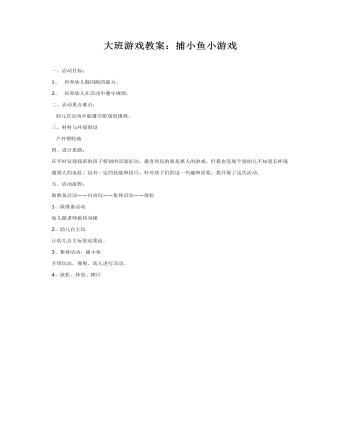
大班游戏教案:捕小鱼小游戏
二、活动重点难点: 幼儿在活动中能遵守游戏的规则。 三、材料与环境创设 户外塑胶地 四、设计思路: 在平时发现我班的孩子特别的活泼好动,最喜欢玩的就是抓人的游戏,但我也发现个别幼儿不知道怎样逃避别人的追赶,没有一定的技能和技巧。针对孩子们的这一兴趣和需要,我开展了这次活动。
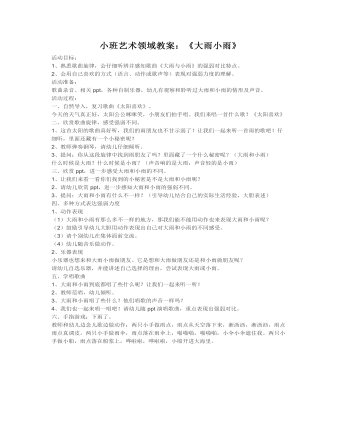
小班艺术领域教案:《大雨小雨》
2、会用自己喜欢的方式(语言、动作或歌声等)表现对强弱力度的理解。 活动准备: 歌曲录音、相关ppt,各种自制乐器,幼儿有观察和聆听过大雨和小雨的情形及声音。 活动过程: 一、自然导入,复习歌曲《太阳喜欢》。 今天的天气真正好,太阳公公咪咪笑,小朋友们拍手唱。我们来唱一首什么歌?《太阳喜欢》 二、欣赏歌曲旋律,感受强弱不同。 1、这首太阳的歌曲真好听,我们的雨朋友也不甘示弱了!让我们一起来听一首雨的歌吧!仔细听,里面还藏有一个小秘密呢? 2、教师弹奏钢琴,请幼儿仔细倾听。 3、提问:你从这段旋律中找到雨朋友了吗?里面藏了一个什么秘密呢?(大雨和小雨) 什么时候是大雨?什么时候是小雨?(声音响的是大雨,声音轻的是小雨)
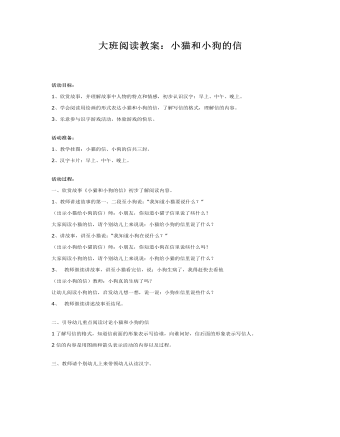
大班阅读教案:小猫和小狗的信
2、学会阅读用绘画的形式表达小猫和小狗的信,了解写信的格式,理解信的内容。 3、乐意参与识字游戏活动,体验游戏的快乐。 活动准备:1、教学挂图:小猫的信、小狗的信共三封。2、汉字卡片:早上、中午、晚上。 活动过程: 一、欣赏故事《小猫和小狗的信》初步了解阅读内容。 1、教师讲述故事的第一、二段至小狗说:“我知道小猫要说什么?” (出示小猫给小狗的信)师:小朋友,你知道小猫子信里说了些什么? 大家阅读小猫的信,请个别幼儿上来说说:小猫给小狗的信里说了什么?
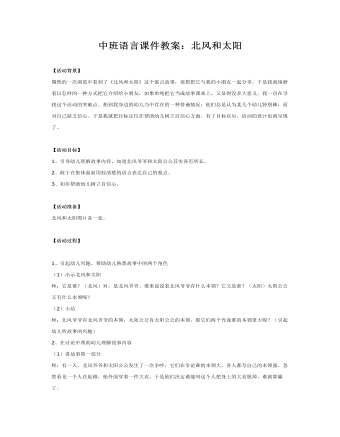
中班语言课件教案:北风和太阳
【活动目标】1、引导幼儿理解故事内容,知道北风爷爷和太阳公公其实各有所长。2、敢于在集体面前用较清楚的语言表达自己的观点。3、初步帮助幼儿树立自信心。 【活动准备】北风和太阳图片各一张。 【活动过程】 1、引起幼儿兴趣,帮助幼儿熟悉故事中的两个角色(1)出示北风和太阳师:它是谁?(北风)对,是北风爷爷。谁来说说看北风爷爷有什么本领?它又是谁?(太阳)太阳公公又有什么本领呢?(2)小结师:北风爷爷有北风爷爷的本领,太阳公公有太阳公公的本领,那它们两个究竟谁的本领更大呢?(引起幼儿听故事的兴趣)2、在讨论中帮助幼儿理解故事内容(1)讲故事第一部分师:有一天,北风爷爷和太阳公公发生了一次争吵,它们在争论谁的本领大,各人都夸自己的本领强。忽然看见一个人在赶路,他外面穿着一件大衣,于是他们决定谁能叫这个人把身上的大衣脱掉,谁就算赢了。
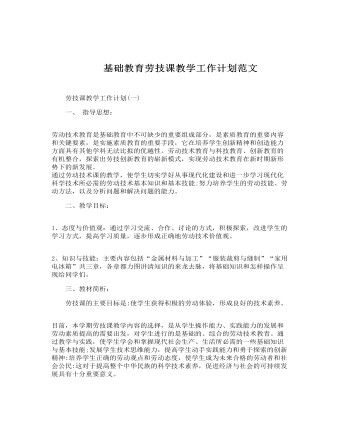
基础教育劳技课教学工作计划范文
1、态度与价值观:通过学习交流、合作、讨论的方式,积极探索,改进学生的学习方式,提高学习质量,逐步形成正确地劳动技术价值观。 2、知识与技能:主要内容包括“金属材料与加工”“服装裁剪与缝制”“家用电冰箱”共三章,各章都力图讲清知识的来龙去脉,将基础知识和怎样操作呈现给同学们。
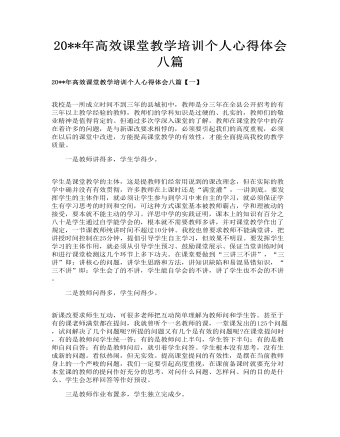
高效课堂教学培训个人心得体会八篇
一是教师讲得多,学生学得少。 学生是课堂教学的主体,这是提教师们经常用说到的课改理念,但在实际的教学中确并没有有效贯彻,许多教师在上课时还是“满堂灌”,一讲到底。要发挥学生的主体作用,就必须让学生参与到学习中来自主的学习,就必须保证学生有学习思考的时间和空间,可这种方式课堂基本被教师霸占,学和理被动的接受,要本就不能主动的学习。洋思中学的实践证明,课本上的知识有百分之八十是学生通过自学能学会的,根本就不需要教师多讲,并对课堂教学作出了规定,一节课教师纯讲时间不超过10分钟。我校也曾要求教师不能满堂讲,把讲授时间控制在25分钟,提倡引导学生自主学习,但效果不明显。要发挥学生学习的主体作用,就必须从引导学生预习、鼓励课堂展示、保证当堂训练时间和进行课堂检测这几个环节上多下功夫。在课堂要做到“三讲三不讲”,“三讲”即:讲核心的问题,讲学生思路和方法,讲知识缺陷和易混易错知识,“三不讲”即:学生会了的不讲,学生能自学会的不讲,讲了学生也不会的不讲。
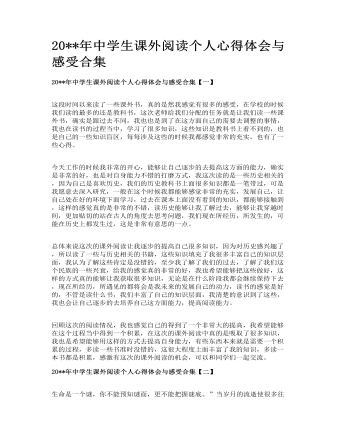
中学生课外阅读个人心得体会与感受合集
总体来说这次的课外阅读让我逐步的提高自己很多知识,因为对历史感兴趣了,所以读了一些与历史相关的书籍,这些知识填充了我很多丰富自己的知识层面,我认为了解这些肯定是没错的,至少我了解了我们的过去,了解了我们这个民族的一些兴衰,给我的感觉真的非常的好,我也希望能够把这些做好,这样的方式真的能够让我获取很多知识,无论是在什么阶段我都会继续保持下去,现在所经历,所遇见的都将会是我未来的发展自己的动力,读书的感觉是好的,不管是读什么书,我们丰富了自己的知识层面,我清楚的意识到了这些,我也会让自己逐步的去培养自己这方面能力,提高阅读能力。
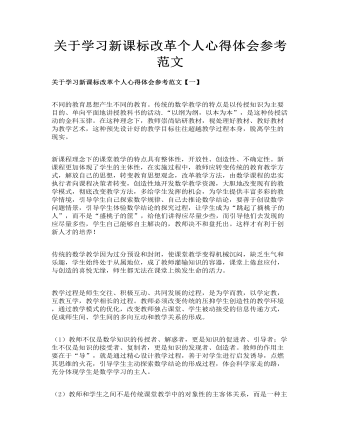
关于学习新课标改革个人心得体会参考范文
传统的数学教学因为过分预设和封闭,使课堂教学变得机械沉闷,缺乏生气和乐趣,学生始终处于从属地位,成了教师灌输知识的容器,课堂上倦怠应付,与创造的喜悦无缘,师生都无法在课堂上焕发生命的活力。 教学过程是师生交往、积极互动、共同发展的过程,是为学而教,以学定教,互教互学,教学相长的过程。教师必须改变传统的压抑学生创造性的教学环境,通过教学模式的优化,改变教师独占课堂、学生被动接受的信息传递方式,促成师生间、学生间的多向互动和教学关系的形成。
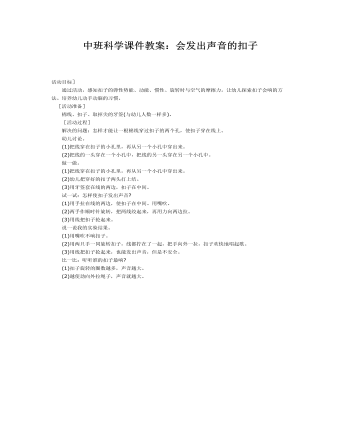
中班科学课件教案:会发出声音的扣子
[活动准备] 棉线、扣子、取掉尖的牙签(与幼儿人数一样多)。 [活动过程] 解决的问题:怎样才能让一根棉线穿过扣子的两个孔,使扣子穿在线上。 幼儿讨论。(1)把线穿在扣子的小孔里,再从另一个小孔中穿出来。(2)把线的一头穿在一个小孔中,把线的另一头穿在另一个小孔中。 做一做。(1)把线穿在扣子的小孔里,再从另一个小孔中穿出来。(2)幼儿把穿好的扣子两头打上结。

